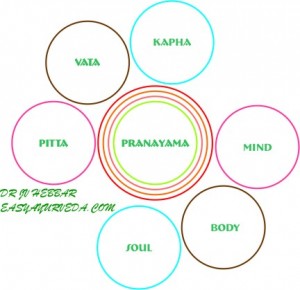Types Of Pranayama – Effect on Health – Through An Ayurveda View-Point
Different types of Pranayama have different effects on our health. The right choice of Pranayama depends on many factors such as body constitution, season, purpose (to treat a disease or for meditation) and so on. Let us see, from an Ayurveda view-point, various types of pranayama and how it affects Tridosha and different aspects of body and mind.

There are different classifications of Pranayama . I have tried to cover as much as possible.
There are lot of Vatas, Pitta’s and Kapha’s in this article. If you really do not have any idea, just remember, Vata is that factor in the body, which has wind like action, Pitta is fire like and Kapha is water like.
For a better understanding of Tridosha (Vata, Pitta and Kapha) you may want to buy my ebook on Tridosha.
Related article: An easy way to understand Tridosha
Table of Contents
Kapal Bhati
Here, the air from the lungs is forcefully exhaled. But inhalation is made involuntarily. Many use this Pranayama in the initial phase of meditation. It helps to improve alertness and concentration.
In Ayurvedic terms, Gheranda Samhita mentions that it mitigates Kapha dosha. The stomach and lungs is where Kapha is prominent. Rigorous exhaling of breath leads to increase in Vata, that is why one feels more alert and active, after this exercise. The Vata has fanning effect over the Kapha. Like water is dried by the wind, Vata helps to balance out Kapha.
Kapha is related to obesity, and this Pranayama strengthens abdominal muscles and helps to burn calories. Hence, it is beneficial for Kapha balance.
Agnisara Pranayama
The air is exhaled out and at that point, abdominal muscles are fanned. This improves digestion power. Hence, it increases Pitta at the level of stomach and intestines. It also activates Vata in large intestines, due to increased abdominal pressure, during this Pranayama.
Bhastrika Pranayama -Bellow’s Breathing
It is meant to increase blood circulation and to activate body channels. It increases Vata to a great extent, and Pitta to a lesser extent.
The Chandranga Bhastrika, practised through the left nostril, influences Ida nadi. It is relatively coolant in nature. Hence it will not increase Pitta, but increases Vata and slightly Kapha.
The Sooryanga Bhastrika – done through right nostril, influences Pingala nadi and increases Pitta more than Vata.
Ujjayi Pranayama – Victorious breathe
It involves making of sound from the throat. Some experts opine that it lowers blood pressure. Some say, that it is useful in treating diseases of ear, nose ad throat. From an Ayurvedic point of view, it stimulates Udana type of Vata, which controls functions like speech, memory, immunity and enthusiasm.
Bhramari Pranayama – Humming bee breathe
It is more targeted towards mind and spirituality than the body. It balances all the three Doshas.
I have heard from a Spiritual Yogi that this makes you “think before you talk” – Based on this explanation, it can be said that it helps to control Vata in mind and in speech. It also increases Kapha to a minor extent.
Nadi Shodhana Pranayama
Balances all the three Doshas.
Sheetkari and Sheetali Pranayama
These are coolant breathing exercises. Mitigates Pitta and increases Kapha and Vata Doshas.
Surya Bhedana Pranayama
It generates heat. It increases Pitta Dosha and decreases Kapha Dosha.
Anuloma Viloma Pranayama
It is a derivative of Nadi Shodhana, excluding the breath holding phase. It balances Tridosha.
Physiology of Pranayama
Take away the spiritual aspects of Prananayama for a while and think. Pranayamas are a simple breathing exercises, made in sitting posture. Most of the Pranayama exercises are exciting and stimulating in nature.
Effect on Vata Dosha
Since it involves breathing, all Pranayamas increase Vata in general. Breathing itself is a Vata activity. But because it involves sitting, and there are concepts of mind control, Vata is not elevated to an extent that it causes diseases.
Effect on Pitta Dosha
Certain type of Pranayama, which generate heat, or stimulate Pingala Nadi tend to increase Pitta, and those that are coolant, like Sheetali and Sheetkari mitigate Pitta.
Effect on Kapha Dosha
Sitting is an inactive pose of the body, hence sitting for long increases Kapha. Hence pranayama does gently increase Kapha. But it, being a mentally very active exercise, and breathing going on in a rhythmic manner, Pranayama does not cause Kapha increase to an extent that it causes diseases. Those types, which generate heat like Kapal Bhati decreases Kapha.
Pranayama does Tridosha balancing act in general with little variations in certain types.










6 comments on “Types Of Pranayama – Effect on Health – Through An Ayurveda View-Point”
mkhari21
Hi Dr Hebbar ji, I have a question regarding pranayamam. I do pranayamam and yoga exercises in early morning. I will have bowel moment after having breakfast. Is it a good practice?. My bowel moments are simulated only after eating food.
Dr J V Hebbar MD(Ayu)
Not a problem.
R Subramanian
Informative article for common man.
Dr J V Hebbar MD(Ayu)
Hi, you will need to consult a Yoga expert for the right advice.
Meenu sharma
Very useful, n easy to understand. Now my question is how can we strengthen our muscles in RA factor, above 500.
prakash bhave
Excellent article.
Shows, certain pranayam may not suit vata type persons except Anulom Vilom.